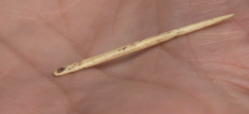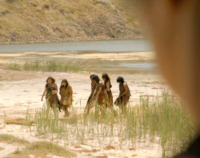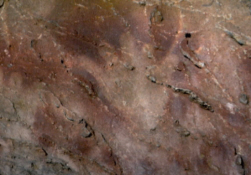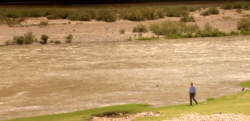Arrival of Clothing
A Resilient Species
Andrew Marr’s History of the World - Age of Survival
30,000 years ago the Neanderthals became extinct, and modern humans - clever, clannish and remarkably violent - were ready to rule the planet. Except that now our ruthless determination came up against something rather more formidable than the Neanderthals.
Around 20,000 years ago, temperatures plunged even further. We were forced once again to adapt or die. Adversity favours the versatile, and this time a very homely piece of technology would make all the difference.

This is a needle, made out of bone. It’s about 17,000 years old. It’s got a beautifully made little eye in it, very similar to the needles you may have at home, and what a needle allows you to do is to wear not animal skins, but clothes that actually fit.
The invention of the needle would help revolutionise human life. Wearing sewn clothing in layers, we could huddle and judder our way through the harsh ice-age winters. We could be out, tracking animals further, hunting for longer - better predators. We had arrows, yes, and spears of course, but the needle was the great, unexpected life-or-death breakthrough.
Modern humans were proving to be one of the most resilient species on the planet, something new under the sun.

But it’s in the French Pyrenees we find evidence that Homo sapiens might live up to the boastful “wise man” label, and hope for something more than survival. We are already trying to mark ourselves out, to understand our place in the world. Here at the Gargas caves in the south of France, we can see our ancestors’ determination to leave a record. What’s down here isn’t exactly art and it’s not graffiti. It’s something more personal and, I think, more emotional.

These marks were made by people like us 27,000 years ago. A hand print - it doesn’t get more personal than that. There is something so common, so ordinary about making a hand print - children in primary schools all over the world still do it - that you can’t help but feel oddly connected to these people who were standing here at the very beginning of the human story.
These hand prints are some of the oldest human markings in the world. Similar prints have been discovered in South Africa, Australia, North America and Argentina. It’s the first example of what you might call recorded history - a universal statement saying, “We are here.”
Arrival of the Farmer
Around 16,000 years ago, the northern hemisphere began to warm up. After tens of thousands of years living as hunter-gatherers at the mercy of nature, this transformation of the world’s climate helped our ancestors to do something radically new.

The River Tigris, eastern Turkey, in the Fertile Crescent. Humans can eat 56 kinds of wild grass, and 32 of them grew here, compared, for instance, to just four in America. Fertile indeed. This is where the single biggest change that humans have ever made to the planet, even in our age of science and great cities… The one thing that has changed Earth more than any other, started here in the “land of the rivers”.
The people who lived in this blessed place ate wild plants, kept a few tame animals, and hunted, but they were also lazy enough to not want to keep walking further to find more tasty seeds to eat. Laziness turns out to be an underestimated force in human history. So, if you don’t want to go to find your food, you can hardly make your food come to you. Or can you?
These are the great anonymous inventors, and it’s from this breakthrough that everything follows. It’s a crucial moment in shifting the balance between humankind and the rest of nature.
It’s not an obvious thing to do. You gather the grains - the food that you’re hungry for and your family is hungry for - but instead of eating it, you keep some of it back… And you take it and you plant it back into the dirt. And then you wait.
To take a seed and plant it seems such an obvious idea now but 13,000 years ago it really was a gamble. It shows thinking ahead, it shows planning, it shows a certain faith.
But by making that simple change, foragers who live throughout the landscape picking things up all over the place are starting to become farmers who have an investment in ONE place on earth. And by choosing the biggest seeds to grow, people reshaped the plants, as well. Bigger seeds and, eventually, bigger everything.
Later on, people in China, India and South America would invent farming for themselves. Three grasses triumphed in ancient times - wheat, rice and corn. 12,000 years on, and they are still the bedrock of the human diet. Farming was the great leap forward, but progress came at a price.
The procurement of adequate clothing may appear to be an insignificant advance; Successfully weathering an ice age would suggest otherwise.
